Helpless on the Wharf

 The Gift of Salvation [line 3 of the map]
The Gift of Salvation [line 3 of the map]
Long periods of wasted time, waiting, and debilitating passivity interrupted all three foundational voyages, draining the enthusiasm and energy of the missionaries. The longest by far was that of the eager pioneer missionaries to Mobile—over a month wasted on the wharves of Le Havre.

The Zamzam was paralyzed by an unexpected wait in port in New Jersey so the captain’s order to blacken every window and porthole could be executed. Besides that, its route was extended; instead of crossing the Atlantic straightaway, its trajectory to Africa was more than doubled by a surplus layover in Brazil. And the Dubuque itinerary was no more direct. It traced a painfully slow northerly water route from New York to Detroit before connecting to a southward meander by stagecoach, only to pivot and zigzag north by riverboat. The abysmal turnabout and delay watching helplessly as local authorities dragged the river for the body of Brother Claudius had to feel eternal.
The key word in those narratives of delay is helpless. Our traveler-forebears learned the hard way that they were not in control. In addition to infuriating waits, epic “acts of God” at sea, like the storm in the Sea of Galilee, fed their panic of death by drowning. The Zamzam didn’t make it; its passengers barely saved the last child of theirs from being sucked into the vortex that consumed the vessel. Ironically, it had been outfitted to be a safe haven. The stout Anna barely handled the Bermuda triangle, and the Dubuque paddle-wheeler burned, fortunately when the brothers were in port.
Anxiety about our salvation
\In our spiritual voyage, we suffer anxiety about our salvation, and we even try to black out our windows so God won’t see us in our times of vulnerability. More manipulatively, we try to save ourselves by silly gestures of piety and good works designed to please or appease God. The concentration camp was a school of you-are-not-in-control, as were the bouts with yellow fever in Mobile. All three missionary teams eventually discovered their fundamental vulnerability; there was no way they could save themselves. That realization became most explicit for the Zamzam survivors, who, over the course of their annual reunions, came to understand that all along God had been working at saving them. They celebrated their faith that God is trustworthy. Like the storm-tossed apostles on the sinking boat who made it back to Capernaum, they ended up laughing with amazement that not one of them had been lost.
As we proceed in our spiritual voyage, we have to leave on the wharf the need to be in control, especially of God.
We leave behind any residual belief that God requires us to earn our salvation or to qualify for a higher place in heaven by a regimen of prayers and good works. God saves us, not we ourselves. In God’s eyes, we don’t, as the American myth would have it, pull ourselves up by our bootstraps. The kingdom of God is not a meritocracy. We have to leave behind the salvation anxiety that has disfigured Catholic spiritual teaching for many of us. In the concentration camp, the captors were gods who set up an incentive system to control the captives. To reward good behavior, they fed the compliant ones more food and rations and the grumblers less. They even set up a brothel where elite compliers could seek comfort!
God doesn’t work like the capo of a POW camp! God saved the chosen people from slavery before there was any question of submitting to the Law. The commandments and the cult around the Ark of the Covenant, it turns out, were a program of filial gratitude and joy for the gift of salvation from Pharaoh’s maw.
A Free Gift
In line 3 of the map of Brother Maurice, we do not do things to convince God to save us—not nine first Fridays, not fasting, not pious devotions, not missionary voyages, not compliance to a Rule. God sent salvation purely “out of love.”
The fathers of Vatican II were crystal clear about that. In a major dogmatic statement, they affirmed “The followers of Christ are called by God, not because of their works, but according to God’s own purpose and grace. They are justified in the Lord Jesus, because in the baptism of faith they truly become children of God and sharers in the divine nature.”[1] We don’t get spiritual to be saved. And we don’t wait until we get to heaven to be saved. We are already!
That liberating good news was reaffirmed in the common confession that the Lutheran Federation and the Catholic Church made at the start of the new millennium. “Together we confess: By grace alone, in faith in Christ’s saving work and not because of any merit on our part, we are accepted by God and receive the Holy Spirit, who renews our hearts while equipping and calling us to good works.”[2]
With Cardinal Joseph Ratzinger as its head, the Vatican doctrinal department added a powerful claim to the Lutheran-Catholic dialogue: “According to the doctrine of the Catholic Church, in baptism everything that is really sin is taken away, and so, in those who are born anew there is nothing that is hateful to God. It follows that the selfish desire[3] that remains in the baptized is not, properly speaking, sin.”[4]
For Brother Maurice and Pope Benedict, our good works and our worship cannot be thought of as part of a dossier to present to God on judgment day full of spiritual affidavits documenting our entitlement to salvation.
We leave such acts of control on the wharf.
A Free Response
Our prayers and works are free responses to the unmerited gift of God’s love. They are gestures of thanksgiving for God’s indulgence toward us. In the complete “God is Love” passage that is the interpretive legend of Brother Maurice’s map, John writes: “We have confidence on the day of judgment. … There is no fear in love, but perfect love drives out fear.”[5] Our Institute’s spirituality is not founded on fear of final judgment. Quite the contrary, since God has saved us with such gratuity, we are freed from the need to waste anxious energy on saving ourselves by, as kids might say it, “brown-nosing” God.
Liberation
Free of angst about our fate, we are liberated to go out to save others. That word liberated takes us back to the event Brothers Andrew and George Aime “cheered and cheered,” when, at the internment camp, “the Royal Marines threw open the gates and called out ‘GENTLEMEN, YOU ARE FREE!’”
 Maurice Zundel, a priest and theologian who had a great impact on Brother Maurice, said, “We are already saved. As Christians, we have been relieved of any worry about our salvation. It is not a question of saving ourselves. We poisoned everything when we made Christianity the religion of saving ourselves, when we made the hideous calculation of putting our good works in a savings account so we can be rewarded with interest. That is vile! We need to love God for who he is, love God to give him a space within ourselves where he can pour out his life in us, where he can show us his love. It is impossible to make a deal or a horse swap with him.”[6]
Maurice Zundel, a priest and theologian who had a great impact on Brother Maurice, said, “We are already saved. As Christians, we have been relieved of any worry about our salvation. It is not a question of saving ourselves. We poisoned everything when we made Christianity the religion of saving ourselves, when we made the hideous calculation of putting our good works in a savings account so we can be rewarded with interest. That is vile! We need to love God for who he is, love God to give him a space within ourselves where he can pour out his life in us, where he can show us his love. It is impossible to make a deal or a horse swap with him.”[6]
Fear of God’s judgment is a second encumbrance we leave on the wharf. Our foundational stories show the validity of trusting in a God of acquittal. The Holy Spirit is our advocate, not our prosecutor. In the Zamzam story we saw the hellish and demeaning results of summary justice. We also saw the outbreak of a delirious jubilee at the moment when mercy triumphed over judgment. God wants us to live in joyful anticipation of that feeling.
Recall also the story of Ambrose: He had been judged guilty of theft,–by whom, we don’t know–unworthy of the voyage, and liable to punishment. Brother Polycarp freed him from the judgment, and Ambrose took off at full speed. The interchange between him and his religious superior is precisely what St. Paul had in mind when he explained to the Romans what happens at the final judgment: Christ steps in as to acquit those who trust his good news that God is love.[7]
Leaving Jansenism behind
Brother Polycarp himself, as a young formation director responsible for the brothers’ dramatic growth curve following the discouraging years of Father Vincent, took for himself and for the Institute a firm stand on the option for salvation as a pure gift. The Jansenists, among them the influential French scientist and theologian Blaise Pascal, had led a crusade against popes and kings for over a century to entrench their option for God as a stern judge who predestines only the elect for salvation. Jansenist artists depicted their heresy through crucifixes like one taken from a cell in a monastery of Jansenist nuns, ten of whom were killed in a violent reactionary raid in 1789 by King Louis XIV during which their convent was completely demolished. The arms of Jesus are vertical, not horizontal; they are narrowly open, signifying that only the few are saved. There is no sign of the open heart.
The Jansenist’s archenemy was the Society of Jesus, which was  reviled by Pascal and the French intellectuals. The Jesuits seized upon the mystical experiences of a cloistered nun in a monastery of a previous era, Margaret Mary Alacoque. She had described apparitions during which Jesus showed her his heart. She had told her Jesuit spiritual director of the promises of grace and salvation that Jesus made and commissioned her to broadcast. She had sketched what she saw. By publicizing her visions, the Jesuits effectively put the heart back on the cross.
reviled by Pascal and the French intellectuals. The Jesuits seized upon the mystical experiences of a cloistered nun in a monastery of a previous era, Margaret Mary Alacoque. She had described apparitions during which Jesus showed her his heart. She had told her Jesuit spiritual director of the promises of grace and salvation that Jesus made and commissioned her to broadcast. She had sketched what she saw. By publicizing her visions, the Jesuits effectively put the heart back on the cross.  They promulgated Margaret Mary’s promises and images through popular devotions and prayers, promoting devotion to the Sacred Heart as an anti-Jansen movement proclaiming God’s gratuitous gift of salvation for all.
They promulgated Margaret Mary’s promises and images through popular devotions and prayers, promoting devotion to the Sacred Heart as an anti-Jansen movement proclaiming God’s gratuitous gift of salvation for all.
While he was novice master in Vals, Brother Polycarp joined the Jesuits’ crusade of re-evangelization against Jansenist spirituality. He made for the Institute a clear option of trust in the liberality of God’s saving grace. He took the Jesuits’ spirit with him when he moved our novitiate to Paradis. There he marked generations of new brothers with the saving image of the Sacred Heart of Jesus. At Paradis, Brother Victorius incarnated the legacy of Brother Polycarp in a composition which the brothers still sing today, “O Heart of Jesus![8] In the context of the struggle against Jansenism, three things are noteworthy about the hymn. It is at once a description of Margaret Mary’s sketch; a musical rendition of the brothers’ coat of arms; and an act of faith in salvation as a gift of hope for all and of consolation to each.
O Coeur de Mon Jesus
O heart of Jesus,
surrounded by flames,
source of all grace,
king of all hearts,
salvation of the human race,
welcome savior of my soul,
I surrender, I let myself be drawn
into your captivating presence.
My heart
– gentle Jesus, this is my fondest hope –
my heart wants only to praise you.
Yes, from the springtime of my life
to the end of my days,
my soul longs to praise you forever.
Forever and ever.
The popes have recognized the power and beauty of devotion to the Sacred Heart as it flourished in many parts of the Church. During the term of Brother Polycarp as superior general, in 1856, Pius IX took the encouraging step of instituting the celebration of the Feast of the Sacred Heart permanently in the Church’s liturgical calendar. In doing so, he proposed to all Christians to seek its abundant spiritual benefits in their own lives. In his turn, at the dawn of the 20th century Leo XIII promulgated the feast and the devotion eloquently as a way to know and respond to God’s gift of salvation.
Papal Guidance
In 1956 Pope Pius XII saw the need to acknowledge criticisms both from secular observers and from within the Church of certain dubious expressions of the devotion. The criticisms would apply to our coat of arms and the hymn of Brother Victorius. In a landmark encyclical letter about the devotion,[9] the pope deflected most of them.
There were two critiques, however, which he studied carefully with nuanced theological arguments. The first was the danger of separating the physical heart of Jesus as an object of adoration apart from his person. The second was the fact that the promises, prayers, images, and practices of the devotion which the Jesuits promulgated were based on private revelations to a single person. Although Margaret Mary was a mystic and a saint, and her visions were judged authentic and consistent with Christian theology, and although they produce the wonderful fruit of intimate prayer, the pope noted that they have no explicit basis in Scripture.
As a remedy, he begins his encyclical with a scripture quote from the Prophet Isaiah: “You will draw water from the wellsprings of salvation.”[10] By doing so, he signals that he wants to transform the devotion 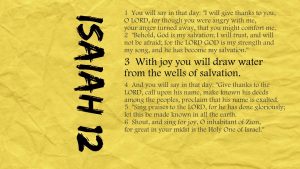 into a spirituality of participation in the central event of salvation history. That history unfolds through the Old and New Testaments and climaxes with the gift of our salvation by Jesus on the cross. For Pius, the springs of salvation which Isaiah foretells are the blood and water flowing from the pierced heart of Jesus on the cross.[11] In the pope’s perspective, the mystical experiences of Margaret Mary are a single instant in the wide arc of salvation history. Her apparitions reinforce, but do not add anything to, God’s saving plan, whose full scope is revealed in Scripture.[12]
into a spirituality of participation in the central event of salvation history. That history unfolds through the Old and New Testaments and climaxes with the gift of our salvation by Jesus on the cross. For Pius, the springs of salvation which Isaiah foretells are the blood and water flowing from the pierced heart of Jesus on the cross.[11] In the pope’s perspective, the mystical experiences of Margaret Mary are a single instant in the wide arc of salvation history. Her apparitions reinforce, but do not add anything to, God’s saving plan, whose full scope is revealed in Scripture.[12]
The Sacred Heart Event
In John’s Gospel, salvation history culminates in an extraordinary event.[13] After Jesus’ crucifixion, a Roman soldier pierces his side with a lance. For Pope Pius, this account, not of a mystical experience, but of an event in recorded history described by an eyewitness, is the source of our spirituality. We can rightly call it the “Sacred Heart Event.”  Scripture scholars point out that the outpouring of blood and water can be explained medically. [14] For John, however, water and blood are well established as signs of salvation.[15] Pius XII confirms that the truth inspiring our spirituality is divine revelation: the blood and water flowing from the pierced heart on the cross have washed over us as an unmerited gift of salvation from a God who sacrifices, suffers, and dies for us.[16]
Scripture scholars point out that the outpouring of blood and water can be explained medically. [14] For John, however, water and blood are well established as signs of salvation.[15] Pius XII confirms that the truth inspiring our spirituality is divine revelation: the blood and water flowing from the pierced heart on the cross have washed over us as an unmerited gift of salvation from a God who sacrifices, suffers, and dies for us.[16]
Under the leadership of Brother Maurice, the general chapters charged with revising the Rule of Life[17] made a clear option to root our spirituality in the prophetic and scriptural tradition developed in Haurietis Aquas rather than in the popular piety associated with Saint Margaret Mary or images of the exposed heart of Jesus. Brother Maurice’s option is clear in the Rule article about our identity as Brothers of the Sacred Heart: “the spirituality of the Institute flows from contemplating Christ, whose open heart is a sign and a revelation of the Trinitarian love of God for all.”[18] Our genuine spirituality develops not from a cell in the Visitation convent of Paray-la-Monial, but from the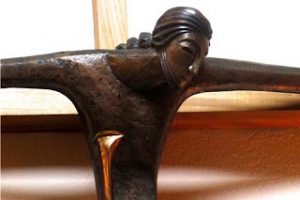 outpouring of waters of salvation from Jesus’ heart pierced on the cross.
outpouring of waters of salvation from Jesus’ heart pierced on the cross.
In his sermons and letters, Father Coindre never refers to Margaret Mary’s visions, although he does use the metaphor of fire to speak of the intensity of Jesus’ love. In one sermon he quotes Isaiah’s “you shall draw waters” verse,[19] but the most convincing way to assess the spirituality that our founder offered is to watch him in action.
The Mission Crosses
The grand dramatic gesture concluding and memorializing each of the parish missions which he and his missionary team preached was the planting of a monumental cross in the town square. There are more than twenty still standing today in towns around Lyons. Brother Jean Roure of France has photographed them and discerned the spiritual message that Father Coindre and the missionaries wanted to affirm through them. They asked the town blacksmith to make a wrought iron cross without a corpus so it would evoke the resurrection and thereby proclaim hope in salvation. Though the crosses’ design included implements of torture – crown of thorns, spear, and nails – their predominant feature was a gold-plated heart at the center. (Some of these and other features have been lost over the years.)
Most of the crosses have rays and floral displays along with gilt leaves or fleurs-de-lis on the branches to suggest a tree of life. Some, decorated with double cascading waves to recall the flow of blood and water, were mounted in the traditional place of the fountain at the center of the town square. To meditate on the gift of our salvation, we could not do better than to contemplate these crosses.
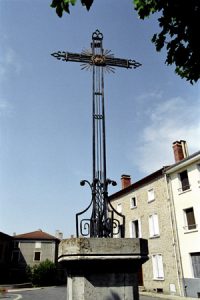
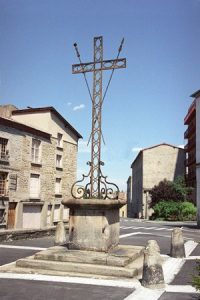


They stand as artistic expressions of the truth of our salvation proclaimed in lines 3 and 4 of our map and through the Sacred Heart event the Evangelist recounts in the Gospel of John, chapters 19 and 20.
The Open Heart
There is another proclamation of that event not crafted of molten iron by muscular mallet. It is article 114 of the Rule of Life. That article was hammered out in words by the General Chapter of 1968-1970 after two years of prayerful contemplation of the scene that describes the gift of our salvation. It received approval by unanimous acclamation of the chapter in 1970. In today’s edition (2007) it stands on page 62 of the 126-page Rule of Life booklet. That places it at the rule’s center, the moral equivalent of the town square:
The Open Heart
The Gospel reveals the pierced side of the Savior
as the source of the life-giving Spirit,
the channel and symbol of divine love.
From his open side,
out of which blood and water flow,
Jesus gives birth
to the Church and the sacraments.
He invites all to his heart
“to draw water with joy
from the springs of salvation.” (Is 12:3)
Brother Maurice Ratté is the recognized writer, editor, proponent, and town crier of this three-sentence proclamation. “We draw our apostolic life,” he says in his circular, “from the pierced heart, which is the source of the life-giving Spirit and the channel of true love.” We join him in spirit with Andre Coindre, Pius XII, John the Evangelist, and the prophet Isaiah in planting it on a pedestal in our heart as a monument of sure hope for our salvation. All of those evangelists of the spirituality of the Sacred Heart did their writing during past stages of the history of our salvation. This portrait of God’s open heart is written in the eternal present.
6
Helpless on the Wharf
The Gift of Salvation
Prayer, Reflection, and Exchange
Prayer of Intercession: The grace I seek …
Pray or sing “O Coeur de mon Jésus,” (above) or let it inspire your own version.
Or pray the song Reckless Love by Cory Asbury
Before I spoke a word
You were singing over me
You have been so, so
Good to me
Before I took a breath
You breathed Your life in me
You have been so, so
Kind to me
[Chorus]
Oh, the overwhelming, never-ending, reckless love of God
Oh, it chases me down, fights ’til I’m found, leaves the ninety-nine
I couldn’t earn it
I don’t deserve it
Still You give yourself away
Oh, the overwhelming, never-ending, reckless love of God
[Verse 2]
When I was your foe
Still Your love fought for me
You have been so, so
Good to me
When I felt no worth
You paid it all for me
You have been so, so
Kind to me
[Chorus]
Oh, the overwhelming, never-ending, reckless love of God
Oh, it chases me down, fights ’til I’m found, leaves the ninety-nine
I couldn’t earn it
I don’t deserve it
Still You give yourself away
Oh, the overwhelming, never-ending, reckless love of God
[Bridge]
There’s no shadow You won’t light up
Mountain You won’t climb up
Coming after me
There’s no wall You won’t kick down
No lie You won’t tear down
Coming after me
[Chorus]
Oh, the overwhelming, never-ending, reckless love of God
Oh, it chases me down, fights ’til I’m found, leaves the ninety-nine
I couldn’t earn it
I don’t deserve it
Still You give yourself away
Oh, the overwhelming, never-ending, reckless love of God
The Sacred Heart Event
Meditation on article 114 – The Open Heart (above)
The early Church Fathers interpret the blood and water sacramentally, as symbols of the blood of the Eucharist and the waters of Baptism. The sacraments and the Church sprang from the wound of Christ’s Heart. St. Augustine makes the connection that just as Eve was drawn from the side of Adam during his “deep sleep” (Gen. 2:21), so too, was the Church, the bride of Christ, drawn from the side of Jesus in His death. It is in the waters of Baptism and the blood of the Eucharist that the Church is born and sustained. The Church appropriately venerates the Sacred Heart of Jesus, which “He allowed to be pierced by our sins,” as the definitive symbol of divine love towards humanity. (Catechism of the Catholic Church 2669)
Golgotha is the new garden of Eden, the cross is the new Tree of Life. The flow from the side of Christ is the new stream watering the garden. Original grace overcomes original sin. The Holy Spirit, in John’s gospel, comes from the Heart of Jesus, not from Pentecost as in Luke.
Meditate on Romans Chapter 5 and on Jean Valjean
“Christ, while we were still helpless, yet died at the appointed time for the ungodly. Indeed, only with difficulty does one die for a just person, though perhaps for a good person one might even find courage to die. But God proves his love for us in that while we were still sinners Christ died for us. How much more then, since we are now justified by his blood, will we be saved through him from the wrath.” (Romans 5:6-9)
These verses from Romans were the inspiration of the opening scenes of Victor Hugo’s Les Miserables. View two clips from the play. The first is the arrest of Jean Valjean after he steals silver from the Bishop’s house. The second is his decision about how to respond.
Psalms of Thanksgiving
Isaiah 12: 1-6 The Promise of Salvation
Psalm 118
Read the Psalm prayerfully as a song of Thanksgiving being constantly sung by Jesus to the Father.
http://www.usccb.org/bible/psalms/118
Cross in the Hand of Andre Coindre
At his missions, Andre was accustomed to preach the sermon on our salvation by holding up a large crucifix. Here is an excerpt from his preaching notes (Manuscript 23), which show the spirit in which the preaching teams erected the public mission crosses.
“Saint Augustine tells us that the cross is a school where Jesus teaches, a pulpit where he announces all the truths of salvation. Jesus speaks to us: ‘When I am lifted up, I will draw all things to myself.’ His silent and sealed lips speak more loudly than if they uttered sounds.
“Instead of us, this cross will preach to you. And what will it say? All the great truths which have been revealed to you and which can never be told. This cross will preach to you instead of us and tell you of one God in three persons. This cross will preach instead of us. And what will it say? It will speak the language of the love of God for us, because he has loved the world to the point of giving us the heart of his only Son. (Jn 3:16). He has loved us to the point of giving us not the heart of a mortal creature, but the heart of the Eternal, the God who reigns above the seraphim and the cherubim, the heart and person of the one who is infinitely greater than the entire universe. He has loved us to the point of dying out of love for us.
“His eyes are lifeless, but it is the love of his heart for you which closed them. His features are pallid and bruised, but it is the love of his heart which has concealed their radiance so as to soften your heart. His lips are silent and sealed, but it is the love of his heart which has made them thus so as to speak to us infinitely more eloquently in the death of God.
“This cross will preach to you instead of us and will reveal to you the price of your souls, the value of your salvation. It will remind you that salvation is our only and necessary treasure, because it is not with gold or silver or precious stones that you have been redeemed, but by the blood of God shed for you. A lance pierced this heart and this wound was desired so as to touch your own hearts with mutual love for him.”
Crucifix of Brother Maurice

Brother Maurice Ratté designed his province’s chapel with an eye toward implementing Vatican II’s as-yet unpublished working documents on liturgical reform as well as the timeless centrality of the “Sacred Heart event.” He wanted to represent “the cosmos filled by a huge but tender crucifix stretching to take on the full dimensions of the universe, at whose center is the wounded side of the Savior.” He was influenced by the writings of the Jesuit paleontologist Teilhard de Chardin who died in 1955. Teilhard wrote in his journal:
“The great secret, the great mystery, is this: there is a heart of the world and this heart is the heart of Christ.…The heart of Jesus fills the whole world; that is, love fills the world. This Sacred Heart was not only the love of Jesus for humanity but also a unifying force upholding the universe. The world happens because of love …The Sacred Heart is the personal heart of the cosmos…the motor of evolution… the heart of the heart of the world, the center of the center of the universe.”[20]
Papal Teaching
Excerpts from the encyclical Deus caritas est (God is Love) of Benedict XVI
- When Jesus speaks in his parables of the shepherd who goes after the lost sheep, of the woman who looks for the lost coin, of the father who goes to meet and embrace his prodigal son, these are no mere words, They constitute an explanation of his very being and activity. His death on the Cross is the culmination of that turning of God against himself in which he gives himself in order to raise man up and save him. This is love in its most radical form. By contemplating the pierced side of Christ (cf. 19:37), we can understand the starting-point of this Encyclical Letter: “God is love” (1 Jn 4:8). It is there that this truth can be contemplated. It is from there that our definition of love must begin. In this contemplation the Christian discovers the path along which his life and love must move.
- Since God has first loved us (cf. 1 Jn 4:10), love is now no longer a mere “command”; it is the response to the gift of love with which God draws near to us.
- We experience the love of God, we perceive his presence and we thus learn to recognize that presence in our daily lives. He has loved us first and he continues to do so; we too, then, can respond with love. God does not demand of us a feeling which we ourselves are incapable of producing. He loves us, he makes us see and experience his love, and since he has “loved us first,” love can also blossom as a response within us.
- Love looks to the eternal. Love is “ecstasy,” not in the sense of a moment of intoxication, but rather as a journey, an ongoing exodus out of the closed inward-looking self towards its liberation through self-giving, and thus towards authentic self-discovery and indeed the discovery of God. “Whoever seeks to gain his life will lose it, but whoever loses his life will preserve it” (Lk 17:33), as Jesus says throughout the Gospels (cf. Mt 10:39; 16:25; Mk 8:35; Lk 9:24; Jn 12:25). In these words, Jesus portrays his own path.
- The Prophets, particularly Hosea and Ezekiel, described God’s passion for his people using boldly erotic images. God’s relationship with Israel is described using the metaphors of betrothal and marriage; idolatry is thus adultery and prostitution.
- God’s passionate love for his people—for humanity—is at the same time a forgiving love. It is so great that it turns God against himself, his love against his justice.
- Love of God and love of neighbor have become one: in the least of the brethren we find Jesus himself, and in Jesus we find God.
- If in my life I fail completely to heed others, solely out of a desire to be “devout” and to perform my “religious duties,” then my relationship with God will also grow arid. It becomes merely “proper,” but loveless. Only my readiness to encounter my neighbor and to show him love makes me sensitive to God as well. Only if I serve can my eyes be opened to what God does for me and how much he loves me.
- Faith, hope and charity go together. Hope is practiced through the virtue of patience, which continues to do good even in the face of apparent failure, and through the virtue of humility, which accepts God’s mystery and trusts him even at times of darkness. Faith tells us that God has given his Son for our sakes and gives us the victorious certainty that it is really true: God is love! It thus transforms our impatience and our doubts into the sure hope that God holds the world in his hands and that, as the dramatic imagery of the end of the Book of Revelation points out, in spite of all darkness he ultimately triumphs in glory. Faith, which sees the love of God revealed in the pierced heart of Jesus on the Cross, gives rise to love. Love is the light—and in the end, the only light—that can always illuminate a world grown dim and give us the courage needed to keep living and working. Love is possible, and we are able to practice it because we are created in the image of God. To experience love and in this way to cause the light of God to enter into the world—this is the invitation I would like to extend with the present Encyclical.
- Those who have drunk from the fountain of God’s love become in their turn a fountain from which “flow rivers of living water” (Jn 7:38).
Pope Pius XII You Shall draw water
Readings from the landmark encyclical Haurietis Aquas
- The love of Jesus, the Son of God, by the sacrifice of Golgotha, cast a flood of light on the meaning of the love of God Himself: “In this we know the love of God, because he has laid down his life for us.” And in truth it was more by love than by the violence of the executioners that our divine Redeemer was fixed to the Cross; and his voluntary total offering is the supreme gift which he gave to each human being, according to that terse saying of the Apostles, “He loved me and delivered himself for me.”
- The Sacred Heart of Jesus shares in a most intimate way in the life of the Incarnate Word, and has been assumed as a kind of instrument of the divinity. It is therefore beyond all doubt that, in the carrying out of works of grace and divine omnipotence, his heart, no less than the other members of his human nature, is also a legitimate symbol of God’s boundless love.
- Under the influence of this love, our Savior, by the outpouring of his blood, became wedded to His Church: “By love, he allowed himself to be espoused to his Church.” Hence, from the wounded heart of the Redeemer was born the Church. … From it flows that plentiful stream of sacramental grace from which the children of the Church drink of eternal life. We read in the texts of the liturgy: “From the pierced Heart, the Church, the Bride of Christ, is born. And he pours forth grace from his Heart.”
- St. Thomas Aquinas writes: “From the side of Christ, there flowed water for cleansing, blood for redeeming. Hence blood is associated with the cup of the Eucharist, and water with the sacrament of Baptism, which has its cleansing power by virtue of the blood of Christ.”
- What is written about the side of Jesus opened by the wound from the soldier, should also be said of the heart which was certainly reached by the stab of the lance, since the soldier pierced it precisely to make certain that the crucified one was really dead. So the wound of the most Sacred Heart of Jesus, now that he has completed his mortal life, remains through the course of the ages a striking image of that spontaneous love by which God gave his only begotten Son for our redemption and by which Jesus Christ expressed such passionate love for us that he offered himself as a bleeding victim on Calvary for our sake: “Christ loved us and delivered himself for us, an offering and a sacrifice to God for an odor of sweetness.”
- After our Lord ascended into heaven with his body adorned with the splendors of eternal glory and took his place by the right hand of the Father, he did not cease to remain with his spouse, the Church, by means of the burning love with which his Heart beats. For he bears in his hands, feet and side the glorious marks of the wounds which manifest his threefold victory won over the devil, sin, and death.
Andre Coindre: Sermon on God’s indulgence toward sinners[21]
Jesus had deference for the dispositions of heart of those who came to him, and instead of judging them, he demonstrated by his indulgence toward sinners that salvation is a pure gift and not a return for our good behavior.
The unnamed woman in the house of the Pharisee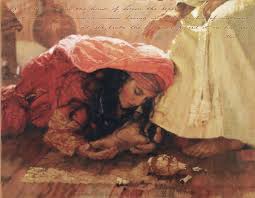
See the sinful woman at his feet. Simon the Pharisee, into whose house Jesus entered, is astonished that he should welcome her with such compassion. In Simon’s eyes, if Jesus knows her to be a public sinner, he ought to rebuff her and refuse the attentions that she seeks to offer him. Simon grumbles about it. Everyone in the house is surprised at this, the woman herself more so than the others. Hardly had she touched his feet than she bathes them with her tears; she weeps over them, and Jesus lets her continue as long as she wishes. She anoints his feet with perfume, and he lets her anoint them as much as she wishes. She presses her lips gently to his feet and he will not draw them away. At that moment all goodness and all openness penetrate her heart; she bursts into tears. She lacks the strength to speak a single word. Her sobs, her disheveled hair, her perfumes floating in the air, her humble and tender kisses, all speak volumes. The more ardent her love, the more intense is her remorse. The more she weeps over her sins, the more the indulgence of Jesus Christ increases her love; her love increases her pain. Without moving from where she is, she experiences true penitence. Already she is suffering martyrdom, and Jesus Christ, who sees into the innermost heart, respects her tears, respects her compunction and the shame to which she exposes herself, and respects the humiliation of her prostrating herself. At that very instant he grants her the complete remission of all her sins. He tells her that her sins, her many sins, are remitted because she has loved much. The one who is indebted loves in proportion to the amount of debts remitted. Jesus tells Simon that the one to whom most is given will likewise love the most: Well, then! Do you see this woman? (Lk 7: 44) She did more for me than you did; you gave me no water for my feet; she has bathed my feet with her tears and dried them with her hair. That is why her many sins have been remitted. (Lk 7: 47). The one to whom less has been forgiven likewise loves less.
The Paralytic Matthew 9
And how many more examples the Savior offers us in other passages in the Gospel! Here there is a paralytic whose intense faith is truly remarkable; Jesus does not send the man to wash in the pool of Siloam to be healed like others. He has respect for the man’s zeal and for the intense trust which led him to have himself brought before Jesus, for, not able to break through the crowd to get into the house into which Jesus had withdrawn, he had the roof uncovered and had himself lowered with ropes to Jesus’ feet. Jesus, seeing their faith, said to the paralyzed man, “Have courage, son, your sins are forgiven.”
The Adultress
And think of another woman, surrounded by an angry crowd ready to stone her. She is most unfortunate, a woman guilty of adultery. The Law of Moses condemned her to death. She was just about to be punished with the execution which she deserved. But Jesus Christ requires that those who are innocent cast the first stone. And, as everyone recognizes his guilt, everyone withdraws. She remains alone with Jesus. Then what an upheaval takes place in her soul! The gentleness of Jesus inspires in her more confusion and 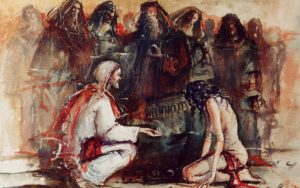
pain than even the severest corrections or the jeers of the crowd. She passes from extreme fear of being stoned to a great peace brought about by gratefulness to Jesus Christ, since everything in her is changed. And Jesus Christ, who reads the depths of her heart, perceives that she is genuinely more repentant than those who undertake long fasts and the most arduous asceticism. Seeing that her soul is changed, he asks: “Woman, has no one condemned you?” “No one, Lord.” “Well, then, neither do I condemn you; go and sin no more!” Behold true repentance, achieved in an instant, thanks to the depths of her gratitude. (Jn 8: 11).
Simon Peter
There is another no less astonishing story of indulgence on the part of Jesus Christ. It is the indulgence he manifested towards his weak and unfaithful disciple, Saint Peter. He had not shown the same sort of indulgence for that disciple who was attached to his family and who asked permission to return to [bury his father] and who heard Jesus say, “He who puts his hand to the plough and looks back is not worthy of the kingdom of God.” Nor was he so indulgent toward that traitorous apostle, since his sacrilege and his deicide [were] punished by the tragic death of a desperate man who had made his rejection final. It is that there was nothing in them which was disposed to mercy. But Peter, on the other hand, had had the misfortune of betraying his Master, but through weakness rather than through wickedness. Before that fateful night, he had been so set on following Jesus that he even protested that he would die for him. Alas! It was presumptuous on his part, but he was not really hard of heart. No sooner had he denied his Master three times than Jesus turned and looked at him. Oh, what power in that look! 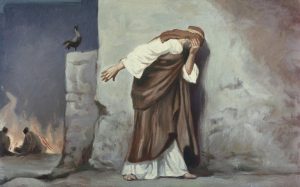 What a sweet reproach did it communicate! And how cut to the quick was Peter! Remembering what Jesus Christ had predicted, he left the place and wept bitterly.
What a sweet reproach did it communicate! And how cut to the quick was Peter! Remembering what Jesus Christ had predicted, he left the place and wept bitterly.
He left the place which had been for him an occasion of sin. That is the first effect of repentance for any sinner who finds himself in situations fraught with danger: to flee and never return again. Then Peter wept bitterly – (Mt 26: 75)—so bitterly in fact that tradition tells us that his tears wrought furrows in his cheeks, so many did he shed. The second effect of the gentle gaze of Jesus upon sinners is that they are as hard on themselves as the Lord is compassionate and good toward them. Also, a single gaze was enough for the Savior to melt Peter; Jesus forgot the sin and forgave him to the extent of making him the leader of the apostles. It is true that, as Peter had denied him three times, Jesus asked for a triple profession of fidelity; however, he does so once again with such goodness that Peter was brought to tears, for Jesus only says, “Do you love me more than these? Tend my lambs, feed my sheep.”
The Penitent Thief
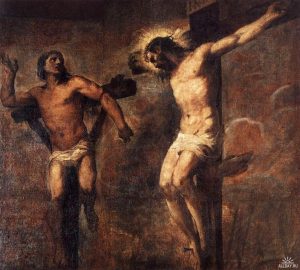 What indulgence! What goodness there is in Jesus! Let us not ignore the indulgence of Jesus for the penitent thief. Ah, it would certainly be a great error [for sinners] to rely on this example to put off their conversion until their last hour! Jesus was merciful and indulgent towards him but without ceasing to be just. It was neither because the man was about to die nor because he was going to die at his side that Jesus Christ pardons him. His woeful companion was likewise going to die, and he was not pardoned because his heart still loved sin. The penitent thief professed the divinity of Jesus Christ just when the crowds were shouting out their blasphemies. He reprimanded his companion, telling him: “Should you not fear God, condemned as you are to the same sentence?” (Lk 23: 41). He recognized Jesus’ innocence and professed it publicly: “This man has done nothing wrong.” (Lk 23: 41). He was full of trust in Jesus, and though he saw that Jesus was suffering the same sentence, he regarded him [as] the King of heaven and spoke this prayer to him: “Lord, remember me when you shall be in your kingdom.” (Lk 23: 42). Nothing more was needed. Jesus Christ, who knows how to read hearts, accepted the man’s words at face value, and in that moment he absolved him of all his crimes and said to him: “Truly I tell [you], today you will be with me in Paradise.” (Lk 23: 43).
What indulgence! What goodness there is in Jesus! Let us not ignore the indulgence of Jesus for the penitent thief. Ah, it would certainly be a great error [for sinners] to rely on this example to put off their conversion until their last hour! Jesus was merciful and indulgent towards him but without ceasing to be just. It was neither because the man was about to die nor because he was going to die at his side that Jesus Christ pardons him. His woeful companion was likewise going to die, and he was not pardoned because his heart still loved sin. The penitent thief professed the divinity of Jesus Christ just when the crowds were shouting out their blasphemies. He reprimanded his companion, telling him: “Should you not fear God, condemned as you are to the same sentence?” (Lk 23: 41). He recognized Jesus’ innocence and professed it publicly: “This man has done nothing wrong.” (Lk 23: 41). He was full of trust in Jesus, and though he saw that Jesus was suffering the same sentence, he regarded him [as] the King of heaven and spoke this prayer to him: “Lord, remember me when you shall be in your kingdom.” (Lk 23: 42). Nothing more was needed. Jesus Christ, who knows how to read hearts, accepted the man’s words at face value, and in that moment he absolved him of all his crimes and said to him: “Truly I tell [you], today you will be with me in Paradise.” (Lk 23: 43).
Oh how beautiful and plenary this indulgence! The man’s sins were forgiven [as much] for his avowal as for his sorrow. His resignation, the voluntary acceptance of the sufferings forced on him, his trust in Jesus Christ allowed him in one single day to avoid the fires of hell and the torments of purgatory, and [threw] open for him eternally both the doors and the delights of Paradise.
Gospel Composition of Place John 21: 1-19
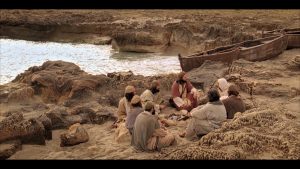
I put myself into the story of the first meeting of Jesus by Peter after he abandoned and denied Jesus. This scene offers a foretaste of how we will be judged.
Hymn of Salvation Blessed Assurance CeCe Wynans
Lyrics
O what a foretaste of glory divine
Heir of salvation, purchase of God
Born of His Spirit, washed in His blood
I in my Savior am happy and blessed
Watching and waiting, looking above
Filled with His goodness, lost in His love
Praising my Savior all the day long
This is my story, this is my song
Praising my Savior all the day long
Praise to the risen King
Death could not hold You, You are victorious
Praise to the risen King
Oh what a Savior
Listening and Mutual Support
In groups or pairs, we share stories of times we or others we know received the gift of “acquittal” as a sign of salvation. We listen as others talk about what the good news of being saved already means for them.
Footnotes:
[1] Lumen Gentium 40
[2] Joint Declaration on the Doctrine of Justification, 1999
[3] “concupiscence”
[4] Response of the Catholic Church to the joint declaration of the Catholic Church and the Lutheran World Federation on the doctrine of justification. 1998
[5] 1 John 4:18
[6] Maurice Zundel, from a retreat preached to Franciscan sisters in Lebanon (July 20-27 1959).
[7] Romans 8:31-35
[8] “O Cœur de mon Jésus”; The original hymn is in French and was published in the hymnal of the Metuchen house of formation. Brother Albertinus Juge brought it, along with his twenty exiles, when Paradis was closed during the 1903 dissolution. It has been learned in the U.S. province by generations of brothers.
[9] cf. Haurietis Aquas (You will draw water [at the springs of salvation.])
[10] Isaiah 12:3 The verse alludes to Isaiah’s song of thanksgiving which foretells the coming savior.
[11] John 19: 31-37 cf. Haurietas Aquas 76-78.
[12] cf. lines 3 and 4 of the map
[13] John 19:31-37
[14] A.F. Saba, Catholic Biblical Quarterly 16 (1954), pp. 438-443
[15] Jn 7:37-39, 6:53-58
[16] Bruce Vawter, “The Gospel of John” in The Jerome Biblical Commentary (Prentice-Hall, 1968), p. 462
[17] 1968 and 1970
[18] Chapter II “The Institute of the Brothers of the Sacred Heart,” article 14
[19] AC:W&D 5, p. 108
[20] Quoted in David Richo, The Sacred Heart of the World (Paulist, 2007), p. 89
[21] Excerpt from AC: W&D 5, p. 208-216. The manuscript is composed of two sermons of André Coindre dealing with the solemn Jubilee proclaimed by Leo XII for the year 1825. This one is a spiritual reflection on the indulgence of God shown in Jesus’ foregoing judgment of sinners.

